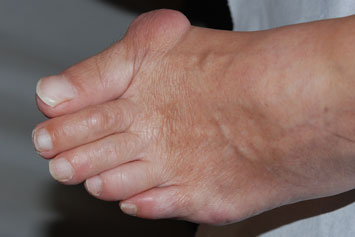 Even though bunions are a common foot condition, they are probably the one with the most misconceptions. Many people suffer unnecessarily with the pain of bunions for years before seeking treatment out of fear about the ?surgery?. The good news is that most bunion pain can be resolved without surgery.
Even though bunions are a common foot condition, they are probably the one with the most misconceptions. Many people suffer unnecessarily with the pain of bunions for years before seeking treatment out of fear about the ?surgery?. The good news is that most bunion pain can be resolved without surgery. Causes
In most cases, bunions are caused by genetics and incorrect foot mechanics. The foot may flatten too much, forcing the toe joint to move beyond normal range. In some cases, arthritis or an injury produces a bunion. In other cases people are simply born with extra bone near a toe joint. Tight fitting shoes further complicate the condition. Shoes such as high heels are particularly damaging to the toes. These shoes have a sloping foot piece and a narrow toe box. The slope causes the front of the foot to be pushed with force into the narrow toe box. The narrow toe box causes the toes to become squeezed together. Depending on factors such as duration of wearing constraining footwear, skeletal maturity, and individual factors, the toes can be- come permanently adapted to the new position and lead to the formation of a bunion. Once a bunion forms, the mechanics of the feet and toes are altered. Tendons begin to pull the toe into an abnormal position, and the problem tends to progress over time.
Symptoms
Many people do not experience symptoms in the early stages of bunion formation. Symptoms are often most noticeable when the bunion gets worse and with certain types of footwear. These include shoes that crowd the toes and/or high-heeled shoes. When symptoms do occur, they may include physical discomfort or pain. A burning feeling. Redness and swelling. Possible numbness. Difficulty walking.
Diagnosis
Orthopaedic surgeons diagnose bunions on the basis of physical examination and weight bearing x-rays. Two angles are assessed, the intermetatarsal angle, that is between the first and second metatarsals (the bones that lead up to the base of the toes). If this angle exceeds 9? (the angle found in the healthy foot) it is abnormal and referred to as metatarsus primus varus. the hallux valgus angle, that is, the angle of the big toe as it drifts toward the small toe. An angle that exceeds 15? is considered to be a sign of pathology.
Non Surgical Treatment
Bunion pain can be successfully managed in the vast majority of cases by switching to shoes that fit properly and don't compress the toes. Your orthopaedic surgeon can give you more information about proper shoe fit and the types of shoes that would be best for you. Follow these general points of shoe fit. Do not select shoes by the size marked inside the shoe. Sizes vary among shoe brands and styles. Judge the shoe by how it fits on your foot. Select a shoe that conforms as nearly as possible to the shape of your foot. Have your feet measured regularly. The size of your feet change as you grow older. Have both feet measured. Most people have one foot larger than the other. Fit to the largest foot. Fit at the end of the day when your feet are the largest. Stand during the fitting process and check that there is adequate space (3/8" to 1/2") for your longest toe at the end of each shoe. Make sure the ball of your foot fits well into the widest part (ball pocket) of the shoe. Do not purchase shoes that feel too tight, expecting them to "stretch" to fit. Your heel should fit comfortably in the shoe with a minimum amount of slippage. Walk in the shoe to make sure it fits and feels right. (Fashionable shoes can be comfortable.) Some shoes can be modified by stretching the areas that put pressure on your toes. Splints to reposition the big toe and orthotics (special shoe inserts shaped to your feet) also may relieve pain. For bunions caused by arthritis, medications can be prescribed to reduce pain and swelling.

Surgical Treatment
If surgery is required to correct a symptomatic bunion, there are several procedures that may be used, depending on the size and degree of the deformity. For mild deformities, a simple shaving of the bony prominence may suffice. At the same time, the tissues on the inner, or medial, side of the joint are tightened to hold the great toe in a more neutral alignment. When only the bone is shaved, this procedure is commonly referred to as a ?Silver? procedure. When the bone is shaved and the soft tissues tightened, this is called a ?modified McBride? procedure.